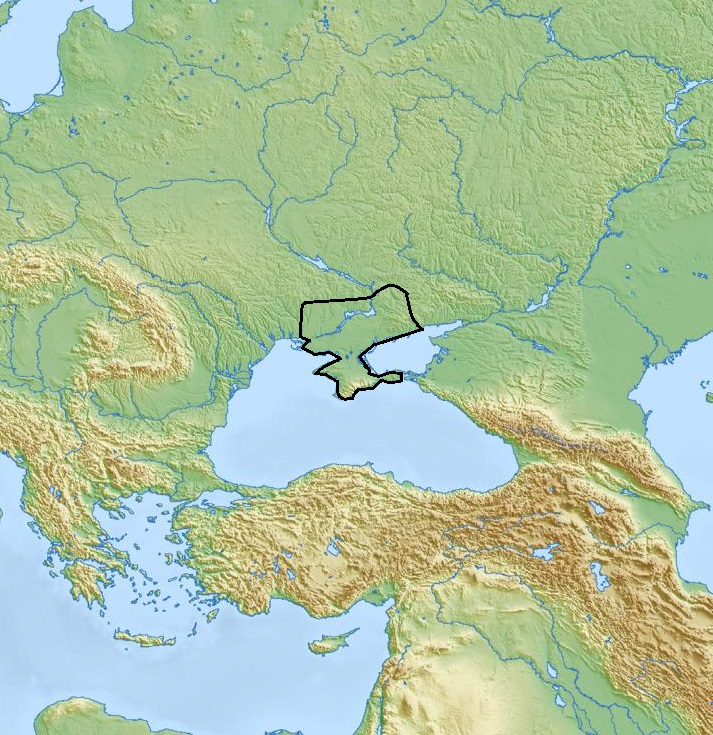Kemi Oba culture on:
[Wikipedia]
[Google]
[Amazon]
 Kemi Oba culture, ca. 3700—2200 BC, an
Kemi Oba culture, ca. 3700—2200 BC, an
 Kemi Oba culture, ca. 3700—2200 BC, an
Kemi Oba culture, ca. 3700—2200 BC, an archaeological culture
An archaeological culture is a recurring assemblage of types of artifacts, buildings and monuments from a specific period and region that may constitute the material culture remains of a particular past human society. The connection between thes ...
at the northwest face of the Sea of Azov
The Sea of Azov ( Crimean Tatar: ''Azaq deñizi''; russian: Азовское море, Azovskoye more; uk, Азовське море, Azovs'ke more) is a sea in Eastern Europe connected to the Black Sea by the narrow (about ) Strait of Kerch, ...
, the lower Bug and Dnieper River
}
The Dnieper () or Dnipro (); , ; . is one of the major transboundary rivers of Europe, rising in the Valdai Hills near Smolensk, Russia, before flowing through Belarus and Ukraine to the Black Sea. It is the longest river of Ukraine and B ...
s and the Crimea
Crimea, crh, Къырым, Qırım, grc, Κιμμερία / Ταυρική, translit=Kimmería / Taurikḗ ( ) is a peninsula in Ukraine, on the northern coast of the Black Sea, that has been occupied by Russia since 2014. It has a pop ...
. The Kemi Oba culture is contemporaneous and partly overlapping with the Catacomb culture
The Catacomb culture (russian: Катакомбная культура, Katakombnaya kul'tura, uk, Катакомбна культура, Katakombna kul'tura) was a Bronze Age culture which flourished on the Pontic steppe in 2500–1950 BC.Parp ...
.
Origins
According to Mallory, this was a component of the largerYamnaya
The Yamnaya culture or the Yamna culture (russian: Ямная культура, ua, Ямна культура lit. 'culture of pits'), also known as the Pit Grave culture or Ochre Grave culture, was a late Copper Age to early Bronze Age archa ...
horizon, while Anthony regards it to be a separate culture, which was replaced by a late Yamnaya variant after 2800 BCE.
Characteristics
The economy was based on both stockbreeding and agriculture. It had its own distinctive pottery, which is suggested to be more refined than that of its neighbors. Theinhumation
Burial, also known as interment or inhumation, is a method of final disposition whereby a dead body is placed into the ground, sometimes with objects. This is usually accomplished by excavating a pit or trench, placing the deceased and objec ...
practice was to lay the remains on its side, with the knees flexed, in pits, stone lined cists or timber-framed graves topped with a kurgan
A kurgan is a type of tumulus constructed over a grave, often characterized by containing a single human body along with grave vessels, weapons and horses. Originally in use on the Pontic–Caspian steppe, kurgans spread into much of Central Asi ...
. Of particular interest are carved stone stelae or menhir
A menhir (from Brittonic languages: ''maen'' or ''men'', "stone" and ''hir'' or ''hîr'', "long"), standing stone, orthostat, or lith is a large human-made upright stone, typically dating from the European middle Bronze Age. They can be foun ...
s that also show up in secondary use in Yamnaya culture
The Yamnaya culture or the Yamna culture (russian: Ямная культура, ua, Ямна культура literal translation, lit. 'culture of pits'), also known as the Pit Grave culture or Ochre Grave culture, was a late Copper Age to ea ...
burials.
Metal objects were imported from the Maykop culture
The Maykop culture (, , scientific transliteration: ''Majkop,''), c. 3700 BC– 3000 BC, was a major Bronze Age archaeological culture in the western Caucasus region.
It extends along the area from the Taman Peninsula at the Kerch Strait to ne ...
. Strong links have been suggested with the adjacent/overlapping Lower Mikhaylovka group
The Mikhaylovka culture, Lower Mykhaylivka culture (3600—3000 BCE) is a Copper Age archaeological culture which flourished on the Pontic steppe from 3600 BC to 3000 BC.
Lower Mikhaylovka culture is named after an early Yamna site of the la ...
.
References
Sources
* *External links
{{Commons category, Kemi Oba culture Archaeological cultures of Eastern Europe Archaeological cultures in Ukraine Bronze Age cultures of Europe Indo-European archaeological cultures